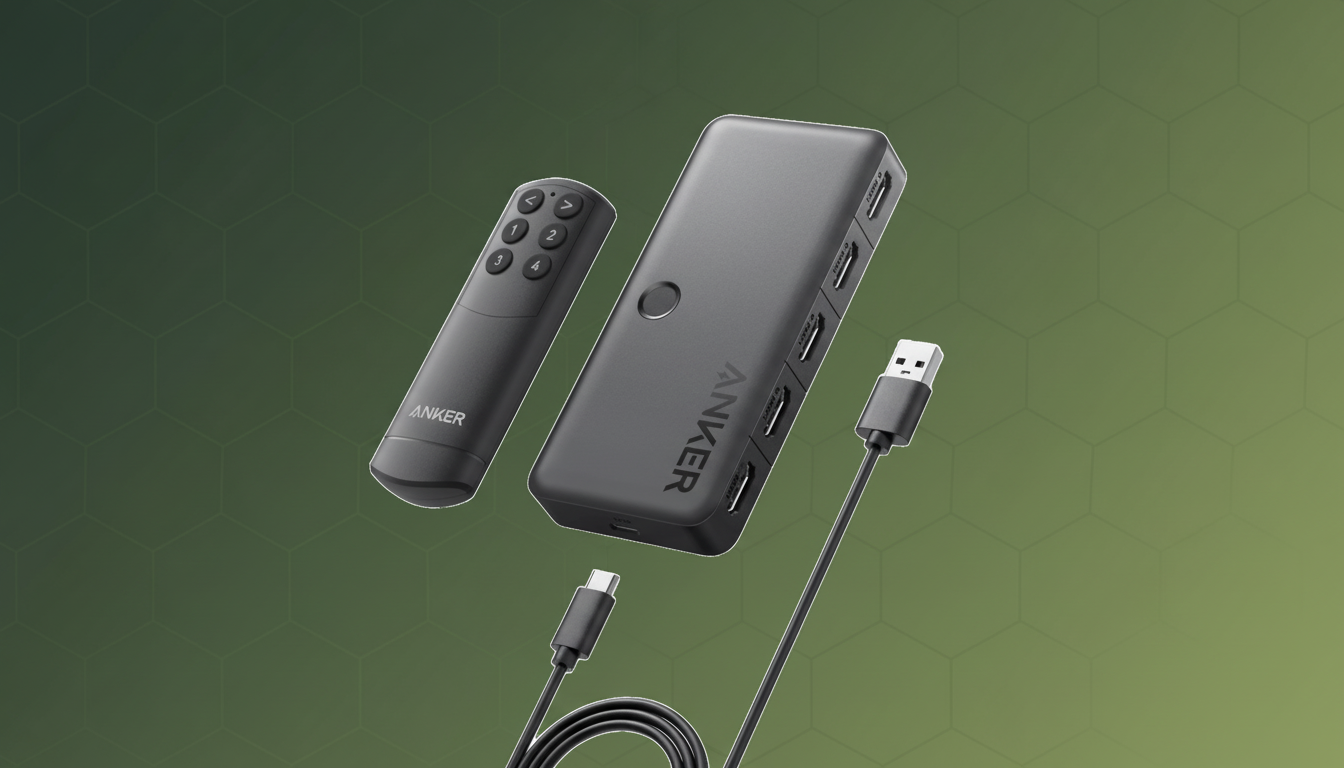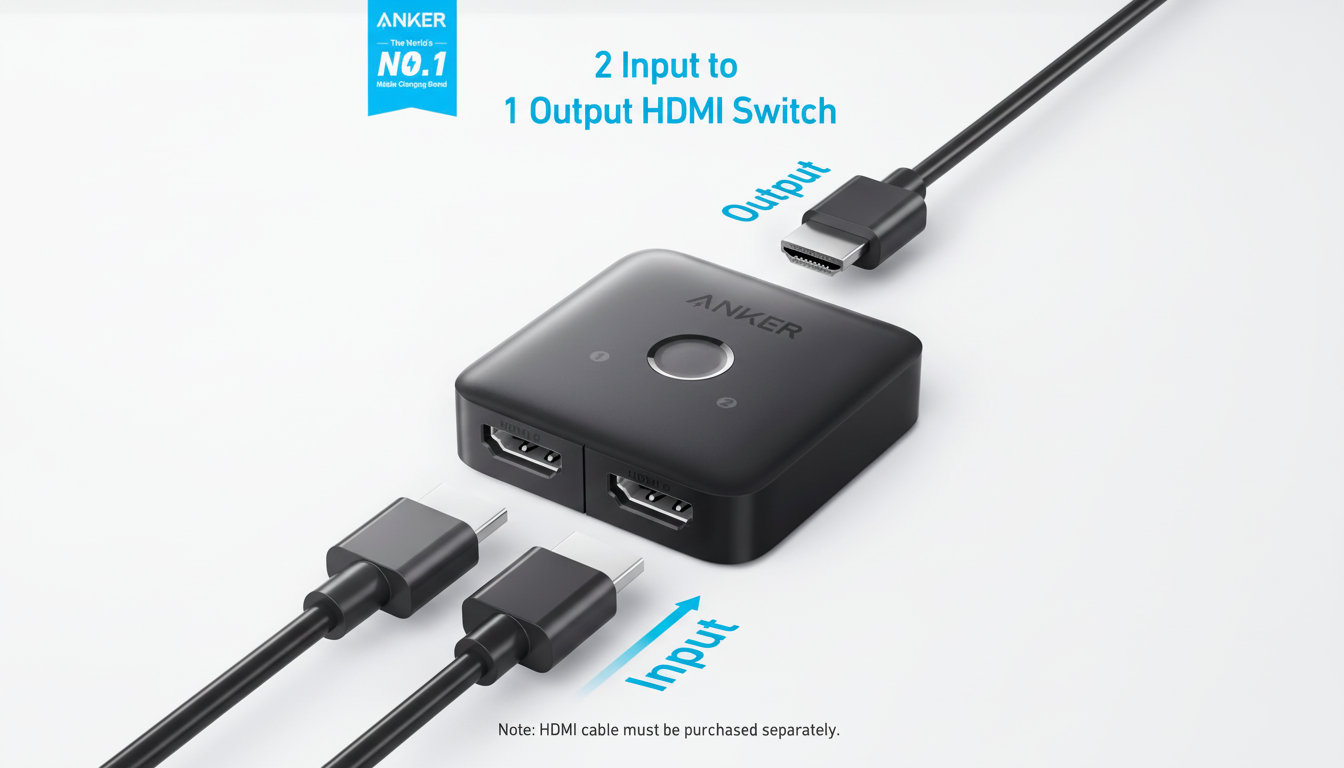One simple, affordable answer is making one monitor double as a hub for two pieces of gear without all that cable shuffling. Meanwhile, a compact HDMI switch by Anker is streamlining your process of switching between sources, and it’s going for $9.99 for members at Amazon right now, down from $15.
Why Get a Switch Over Swapping Out Cables
Relatively new monitors and TVs are being sold with fewer (for them) HDMI ports at lower price levels, putting users in a position of having to unplug from one to plug into another. It’s not just annoying; that routine plugging can put stress on ports and wear down cables over time. With an HDMI switch, you won’t need to worry about any of that: just keep both devices plugged in and switch between inputs with the press of a button.
- Why Get a Switch Over Swapping Out Cables
- What the Tiny Box Provides for Everyday Switching
- Quick Setup in Minutes for a Two-Device Monitor
- Performance Implications and Cable Considerations
- Real-World Use Cases for One Monitor, Two Devices
- Price Snapshot and Value for Budget-Friendly Switching
- Bottom Line: A Simple, Effective Two-Device Switch

For students in too-tight dorm rooms, remote workers juggling a laptop and desktop, or living rooms where a console competes with a streaming stick, a switch is the frictionless fix. It also keeps cable runs neat, which counts when a screen is wall-mounted or otherwise hard to access.
What the Tiny Box Provides for Everyday Switching
The Anker model is a simple 2-in/1-out HDMI switch, pure and simple. You hook up the single HDMI output to a monitor or TV and then you plug in two source devices to its inputs. Changing sources is done with the push of a physical button on the device, so you can be assured that you’re actually selecting what you want to select, rather than accidentally flipping inputs as one might do with an auto-switcher.
On performance, it can handle up to 4K resolution at 60 frames per second, SDR and HDR, 3D video, and multichannel audio in formats such as Dolby. That spec profile matches mainstream needs such as 4K streaming boxes, Blu-ray players, and current consoles running at 4K60. It’s compact, at roughly 2.17 x 2.17 x 0.57 inches with a metallic finish, so it can invisibly hide behind a monitor and doesn’t feel cheap or flimsy.
Quick Setup in Minutes for a Two-Device Monitor
Install is plug-and-play. Plug the switch into your screen’s HDMI port, and connect both of your devices to the box’s labeled inputs. Turn your display on and the connected switch, then press a button to switch the active source. If you take audio seriously, keep the display’s dedicated HDMI port free for ARC or eARC and route sources through the switch so as not to cut off return-channel audio to your soundbar or AVR.
For TV-couch control, some users attach the switch to a small adhesive pad on the edge of a TV stand so the button is accessible. The rest of us run longer input cables and mount the switch next to a desk keyboard for easy back-and-forth switching between a work laptop and a gaming PC.

Performance Implications and Cable Considerations
The sweet spot is HDMI 2.0 signaling at 4K60 with HDR. The HDMI Forum’s published specs set the HDMI 2.0 bandwidth limit at 18 Gbps, which is sufficient for 4K60 with typical streamer and disc color formats and bit depths. If you are aiming for 4K120, VRR, or 8K from a next-gen console to a high-refresh gaming monitor, you’ll also need an HDMI 2.1 switch (though these are pricier and less prevalent).
Use higher signal-integrity certified cables, particularly for longer runs or HDR. Individual cable length should not be too long, or it can weaken the signal; shorter is better. One high-quality short cable can beat one extra-long cable. And if you watch 4K content through services that lock down the content, make sure your chain is HDCP 2.2-compliant all the way through, including the switch. Many common switches are, but you should check to ensure trouble-free playback.
Real-World Use Cases for One Monitor, Two Devices
- Work and play on one monitor: Route your work laptop or office computer into the switch and use your other input for your gaming computer or console.
- Console + PC: Game at 4K60 on one display and work from a PC with just a click.
- Streaming box with Blu-ray player: Keep your favorite 4K streamer and a disc player ready to go, sharing the same TV input.
If you also have to swap a keyboard and mouse between two computers, a KVM is what you want. But for strictly video and audio switching, a simple HDMI switch is still smaller, cheaper, and easier to hide.
Price Snapshot and Value for Budget-Friendly Switching
The current $9.99 member price is a significant value for an everyday problem-solver. Even when they are not on sale, dumb 2×1 switches generally still beat the price of upgrading to a top-tier monitor just for more ports. But more than half of U.S. households now have at least one 4K set, according to research firms like Leichtman Research Group, so practical add-ons that help tame multi-device living rooms and desks continue paying dividends.
Bottom Line: A Simple, Effective Two-Device Switch
If you’re sick of crawling behind your TV or monitor, the simplest solution is a small HDMI switch. The Anker model’s 2-in/1-out architecture, 4K60 and HDR compatibility, and buttons you can actually press combine to provide a hassle-free way to run two devices on one screen—no juggling ports or feature compromises in sight.

